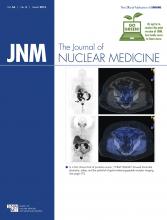Abstract
Our objective was to compare the quality and diagnostic performance of 18F-fluoride PET/MR imaging with that of 18F-fluoride PET/CT imaging in patients with foot pain of unclear cause. Methods: Twenty-two patients (9 men, 13 women; mean age, 48 ± 18 y; range, 20–78 y) were prospectively included in this study and underwent a single-injection dual-imaging protocol with 18F-fluoride PET/CT and PET/MR. At a minimum, the PET/MR protocol included T1-weighted spin echo and proton-density fat-saturated sequences in 2 planes each with simultaneous acquisition of PET over 20 min. PET/CT included a native isotropic (0.6 mm) diagnostic CT scan (80 kV, 165 mAs) and a subsequent PET scan (2 min per bed position). By consensus, 2 masked interpreters randomly assessed both PET datasets for image quality (3-point scale) and for the presence of focal lesions with increased 18F-fluoride uptake (maximum of 4 lesions). For each dataset (PET/CT vs. PET/MR), the diagnoses were defined using both PET and a morphologic dataset. Standardized uptake values (SUVs) from the 2 devices were compared using linear correlation and Bland–Altman plots. Moreover, we estimated the potential for dose reduction for PET/MR compared with PET/CT considering the longer acquisition time of PET/MR analyzing count rate statistics. Results: Image quality was rated diagnostic for both PET datasets. However, with a mean rating of 3.0/3 for PET/MR and 2.3/3 for PET/CT, image quality was significantly superior for PET/MR (P < 0.0001). The sensitivity of the PET datasets in PET/MR and PET/CT was equivalent, with the same 42 lesions showing focal 18F-fluoride uptake. In PET/MR, the mean SUVmean was 10.4 (range, 2.0–67.7) and the mean SUVmax was 15.6 (range, 2.9–94.1). In PET/CT, the corresponding mean SUVmean of PET/CT was 10.2 (range, 1.8–55.6) and the mean SUVmax was 16.3 (range, 2.5–117.5), resulting in a high linear correlation coefficient (r = 0.96, P < 0.0001, for SUVmean and for SUVmax). A final consensus interpretation revealed the most frequent main diagnoses to be osteoarthritis, stress fracture, and bone marrow edema. PET/CT was more precise in visualizing osteoarthritis, whereas PET/MR was more specific in nondegenerative pathologies because of the higher soft-tissue and bone marrow contrast. The longer acquisition time of MR compared with CT would potentially allow 18F-fluoride dose reduction using hybrid 18F-fluoride PET/MR imaging of at least 50% according to the counting rate analysis. Conclusion: In patients with foot pain of unclear cause, 18F-fluoride PET/MR is technically feasible and is more robust in terms of image quality and SUV quantification than 18F-fluoride PET/CT. In most patients, 18F-fluoride PET/MR provided more diagnostic information at a higher diagnostic certainty than did PET/CT. Thus, PET/MR combines the high sensitivity of 18F-fluoride PET to pinpoint areas with the dominant disease activity and the specificity of MR imaging for the final diagnosis with the potential for a substantial dose reduction compared with PET/CT.
Footnotes
↵* Contributed equally to this work.
Published online Feb. 12, 2015.
- © 2015 by the Society of Nuclear Medicine and Molecular Imaging, Inc.







